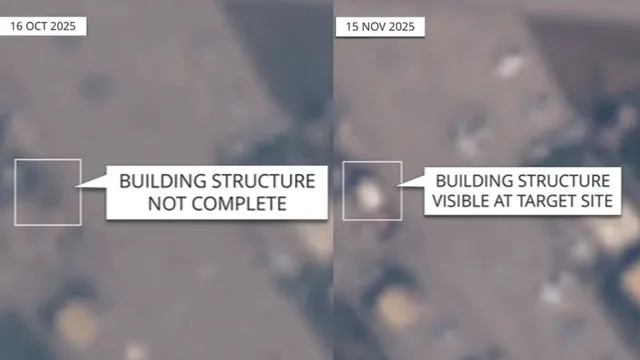- By Supratik Das
- Tue, 18 Nov 2025 12:03 PM (IST)
- Source:JND
Nearly six months after India launched Operation Sindoor and struck multiple high-value military installations inside Pakistan, fresh satellite imagery indicates that Islamabad is still struggling to rebuild critical infrastructure hit during the four-day conflict.
New Facility Spotted At Nur Khan Airbase
Latest visuals shared by OSINT analyst Damien Symon show a newly constructed structure at the exact location inside Rawalpindi’s Nur Khan Airbase where Indian missiles landed on May 10.
The airbase, situated less than 25 km from Islamabad, is one of Pakistan’s most sensitive military hubs. It houses transport squadrons, aerial refuelling units, PAF College Chaklala, and the elite No. 12 VIP Squadron, which ferries the country’s top civilian and military leadership.
Pakistan appears to have constructed a new facility at Nur Khan Airbase, at the location India targeted during its May 2025 conflict pic.twitter.com/eG8FT3a1Qu
— Damien Symon (@detresfa_) November 16, 2025
According to Symon, the building now visible in satellite images stands on the remains of a secured compound where India destroyed two special-purpose trucks believed to be linked to command-and-control operations. Pakistan’s Prime Minister Shehbaz Sharif had later publicly acknowledged that Indian missiles struck Nur Khan and several other sensitive locations.
Jacobabad Airbase Repairs Still Underway
Separately, satellite images from Jacobabad Airbase in northern Sindh reveal that the hangar hit by Indian strikes remains under repair. The roof has been dismantled in phases over the past few months. Symon noted that such a step-by-step removal typically indicates structural assessments of internal damage before full reconstruction can begin. The slow pace of repairs suggests the strike caused deeper damage than initially acknowledged.
Imagery over the past few months reveals the hangar targeted by India at Jacobabad Airbase, Pakistan during the May 2025 conflict, has had its roof taken apart in stages likely as internal damage checks continue before the structure is repaired pic.twitter.com/DNmgKnmEEv
— Damien Symon (@detresfa_) November 15, 2025
During the May conflict, India targeted 11 Pakistani military installations, including major airbases at Murid, Rafiqui, Mushaf, Bholari, Qadrim, Sialkot and Sukkur. The strikes were launched in response to the Pakistan-backed Pahalgam terror attack in April that killed 26 civilians. Indian officials had said that Pakistan suffered “very heavy” and “unsustainable losses” during the brief conflict. Wing Commander Vyomika Singh had stated in May that India’s precision operations degraded Pakistan’s capability to wage further attacks.
Significance Of Nur Khan Strike
The Nur Khan strike was considered one of the most consequential hits during Operation Sindoor, as the base lies close to Pakistan’s Strategic Plans Division, the organisation responsible for oversight of the country’s nuclear arsenal. Post-strike images had shown rubble, collapsed roofing, burning fuel vehicles, and debris scattered dangerously close to the main runway.
ALSO READ: COAS General Dwivedi Calls Operation Sindoor An ‘88-Hour Trailer,’ Warns Pakistan
In July, Symon had also released satellite imagery from the Kirana Hills region, claiming it showed the impact site of India’s strike on what has long been suspected to be a nuclear weapons storage complex.
ALSO READ: Pakistan Reaches Another 'Toxic' Milestone, Becomes World’s Most Polluted City As AQI Hits 632
The ongoing reconstruction activity, six months after the operation, suggests Pakistan is still attempting to restore key defence infrastructure. The latest satellite evidence indicates that the damage inflicted by India’s precision strikes was extensive and continues to affect operational readiness at several bases.

